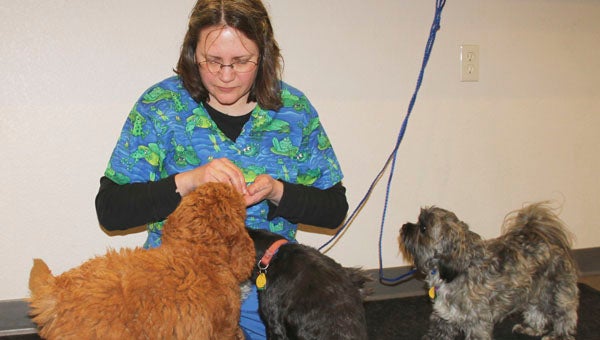Helping with animal behavior issues
Published 9:34 am Thursday, April 28, 2011

Lori Payne uses treats as positive reinforcement with three puppies at the Clarks Grove-Waseca Veterinary Clinic on Friday. -- Michelle Haacke/Albert Lea Tribune
CLARKS GROVE — From cats to dogs and horses to llamas, Lori Payne has found that positive reinforcement is key when working with animal behavior issues.
Food rewards and praise are a good start.
“You want to try to set them up for success,” she said. “If you’re teaching them the word, ‘come,’ then say it when the dog is coming toward you instead of pulling on their leash.”
Payne, a veterinary technician at Clarks Grove-Waseca Veterinary Clinic, has had some formal training in animal behavior. However, much of what she’s learned has been through her own personal experience. She has participated in American Kennel Club obedience shows and has nine dogs at home.
“What works for one doesn’t necessarily work for others,” she said. “My dogs are a variety of breeds, and certain breeds are prone to certain problems.”
Payne said the biggest problem with dogs is often linked to their owners.
“People tend to love their dogs so much, they’re afraid to correct or discipline them,” she said. “They want their dog to be happy, like children, but they need rules and boundaries, too.”
Payne said you don’t have to be a “hard taskmaster” to make positive changes in dogs, or other sorts of pets. It’s as simple as teaching dogs to sit by saying the word “sit” to them while they are already sitting. A doggie treat upon the desired behavior is the reward. Eventually, it’s OK to stop rewarding their pets, but the occasional reward long after they’ve learned the correct behavior still helps them know they’re on track.
“You have to find out what works best for your dog,” she said.
Cats, however, are a whole different ballgame. Because of the way cats are internally wired, it’s more of a challenge to find out if a certain unwanted behavior is a physical medical issue or a behavioral issue.
“Dogs want to please the leader of their pack, but cats are solitary animals,” she said. “Cats have been domesticated for a very long time, but we still have this problem because they stay a little closer to the wild side.”
The most frequent complaint with cats is urination problems indoors — and not inside their litter boxes. For this widespread issue, she suggested placing multiple litter boxes in various locations around the house and trying different kinds of litter. This is especially important in households with more than one cat, she said as she recalled a two-cat household with a “victim” and a “bully” cat.
“The litter box was in a corner in an area where if the victim cat went in to use it, the bully cat would trap her in the box,” she said.
Payne, who has worked at the Clarks Grove-Waseca clinic for about six years, began working with llamas a few years ago when her children started showing them in 4-H. She likened them to working with horses. Making them feel safe is key.
“If they feel safe, they will try new things for you,” Payne said.
As manager of the boarding kennel at the clinic, Payne said making dogs feel safe is key in making them comfortable when they are boarded. She said they do whatever they can to make the dogs feel comfortable, safe and happy during their stays.
Figuring out how to get the animals to do what you want them to do instead of making them do something is also important in modifying animal behaviors.
Payne said everyone in the clinic offers up behavior consulting for concerned pet owners. While she does some consulting over the phone, most of the time it’s something that comes up in conversation when people have their animals in the office for a medical problem.
Because of liability reasons, however, Payne and the staff at the Clarks Grove-Waseca Veterinary Clinic are not certified to handle adult dog aggression. For that, she suggested contacting a certified dog trainer.
Payne also recommended people to contact their own veterinarians for any concerns related to their pet’s behavior.



